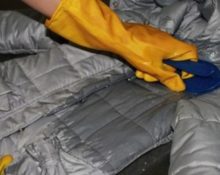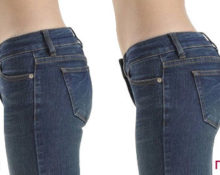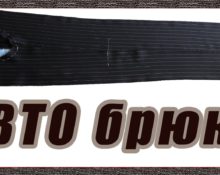Many have encountered the imprudence of staining their clothes with paint. A recently painted bench in the park, a trip to the country, time spent with a child drawing - all this can lead to the appearance of small stains. This misunderstanding does not mean that the item has completely deteriorated. Stains from any paint can be removed and clothes can be returned to their previous condition. Find out how to do this in this article.
Types of pollution
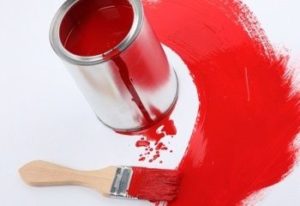 The reason is different types of paint. They differ in their purpose and functionality, therefore they have different composition, consistency and chemical properties. All characteristics are taken into account when choosing a suitable product.
The reason is different types of paint. They differ in their purpose and functionality, therefore they have different composition, consistency and chemical properties. All characteristics are taken into account when choosing a suitable product.
- Paints for painting. All types contain two mandatory components: coloring parchment and an adhesive base. Watercolor and gouache have a similar composition: they contain resin, gum, and sometimes honey. They dissolve easily in water. Oil varieties add oils, beeswax and soft resin. They are much more labor-intensive to remove, since they do not dissolve in water.Tempera paints are also difficult to remove: they contain egg yolk, wax, and are oil-based.
- For repairs (silicone, oil, alkyd). Oily ones contain drying oils and oils; they are quite durable. Silicone includes water, resin, organic elements.
- Cosmetic (for hair, eyebrows and eyelashes): pigment and ammonia.
- Food.
The most problematic varieties are repair paints. Kinds:
- Oily. The composition includes pigment powder and synthetic oil. They are unstable to alkaline environments.
- Alkyd. Made on the basis of alkyd varnish with the addition of solvent.
- Water-based. Quick-drying material, composition: pigments and water.
- Latex. The composition is based on acrylic resin.
- Enamel. Material: glass powder. Form a dense protective layer on the surface.
The most difficult to remove are enamel and latex paints. Their composition does not allow them to dissolve quickly. It is IMPORTANT to wash off the stain immediately, otherwise it will be almost impossible to wash it later.
Fresh contaminants
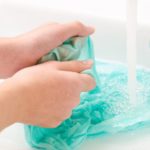 It is easiest to remove stains that have appeared recently and have not had time to be absorbed and crusted over. To do this, use handy means: ammonia, vegetable oil and solvents. They get rid of unpleasant stains on any fabric.
It is easiest to remove stains that have appeared recently and have not had time to be absorbed and crusted over. To do this, use handy means: ammonia, vegetable oil and solvents. They get rid of unpleasant stains on any fabric.
Latex/acrylic dyes
They contain water, so they are the easiest to get rid of. HELP Before proceeding with the main steps, remove the remaining paint layer using a paper knife or other sharp object.
Laundry soap
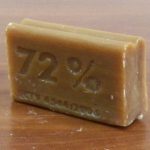 Suitable for pen marks.
Suitable for pen marks.
Soak the trousers in cool water, apply soap to the necessary areas with a bar of soap and scrub thoroughly. Don't let it dry out.
Powder + butter (suitable for fresh stains)
Crush the required amount of oil, add the powder. Apply the mixture to the desired areas, leave for half an hour until it is absorbed. Rub thoroughly and wash the product in cold water. Dark items tolerate this procedure better. Oil can be replaced with vegetable oil. HELP: The stain remover will remove any greasy stains that have formed.
Glycerin + alcohol
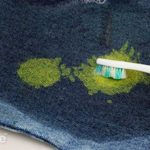 Suitable for stubborn stains and inks.
Suitable for stubborn stains and inks.
Steam the glycerin and rub the substance into the fabric using a cotton pad. After the procedure, wash the product. A mixture of glycerin and alcohol is suitable for thin, delicate fabrics. Moisten the stain first with alcohol, then with glycerin, rub, rub.
Water based paints
The above methods are suitable. If these don't help, there are more intensive methods. It is IMPORTANT to try more gentle elements first.
Stain remover
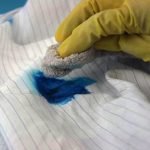 The choice of a suitable product is based on the characteristics of the fabric and its color. For light-colored clothes: boil water, add stain remover to it. Place the item completely in boiling water and leave for several hours, then wash. Be careful with colored items: some fabrics lose their properties and color after contact with boiling water.
The choice of a suitable product is based on the characteristics of the fabric and its color. For light-colored clothes: boil water, add stain remover to it. Place the item completely in boiling water and leave for several hours, then wash. Be careful with colored items: some fabrics lose their properties and color after contact with boiling water.
Vinegar + ammonia
The mixture is suitable for stubborn stains.
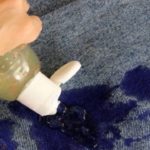 Mix ammonia and vinegar in a 1:1 ratio, apply to the required areas using a cotton pad or sponge, leave for an hour: the product will be absorbed. Afterwards wash using laundry soap. HELP: if the item is light in color, add hydrogen peroxide to the mixture. The substance will prevent the formation of streaks.It is also useful for removing blood stains and bleaching: apply the liquid to stains, leave until completely absorbed, and wash.
Mix ammonia and vinegar in a 1:1 ratio, apply to the required areas using a cotton pad or sponge, leave for an hour: the product will be absorbed. Afterwards wash using laundry soap. HELP: if the item is light in color, add hydrogen peroxide to the mixture. The substance will prevent the formation of streaks.It is also useful for removing blood stains and bleaching: apply the liquid to stains, leave until completely absorbed, and wash.
Old stains
Even if the stain is several days old, it can be removed. For this purpose, more aggressive substances are used. They can damage the fabric and ruin its color. These substances include gasoline, kerosene, acetone and solvent. REFERENCE: these liquids can quickly and effectively remove traces of paint, but you need to make sure that they are harmless to the product. Before the procedure, check the reaction of the fabric in a hidden area of clothing.
Enamel and oil paints
Acetone, gasoline, kerosene
It is IMPORTANT to use pure, purified liquids. Otherwise they will leave divorces.
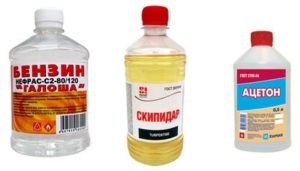 Use a sharp object to remove any remaining dried paint from the fabric. Cover the item with a clean cloth and rub one of the listed products into the stain. For convenience, use a sponge or cotton pad. After the procedure, wash the item with added laundry soap - this will eliminate unwanted stains. Wash in a washing machine, doubling the amount of detergent.
Use a sharp object to remove any remaining dried paint from the fabric. Cover the item with a clean cloth and rub one of the listed products into the stain. For convenience, use a sponge or cotton pad. After the procedure, wash the item with added laundry soap - this will eliminate unwanted stains. Wash in a washing machine, doubling the amount of detergent.
Solvent
Moisten the desired area with the product and leave for half an hour. Wash away any remaining dirt using laundry soap or another detergent. After treatment, it is MANDATORY to wash the item in a machine, adding a large amount of fabric softener - the unpleasant odor will disappear. It is IMPORTANT not to overdo it: the less time the solvent acts on the fabric, the better.
White spirit
Used for particularly difficult cases.
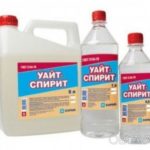 Dampen a clean cloth with the product and treat the stain along a path “from the edges to the center.” If necessary, repeat the procedure until the contamination completely disappears.Wash with laundry soap and machine wash with plenty of conditioner. You may need to re-wash as the odor of white alcohol is too strong, strong and offensive. Test the tissue's reaction to liquid in advance in an inconspicuous area. White spirit is a very strong and caustic substance; it can discolor the material or completely ruin it.
Dampen a clean cloth with the product and treat the stain along a path “from the edges to the center.” If necessary, repeat the procedure until the contamination completely disappears.Wash with laundry soap and machine wash with plenty of conditioner. You may need to re-wash as the odor of white alcohol is too strong, strong and offensive. Test the tissue's reaction to liquid in advance in an inconspicuous area. White spirit is a very strong and caustic substance; it can discolor the material or completely ruin it.


 1
1
